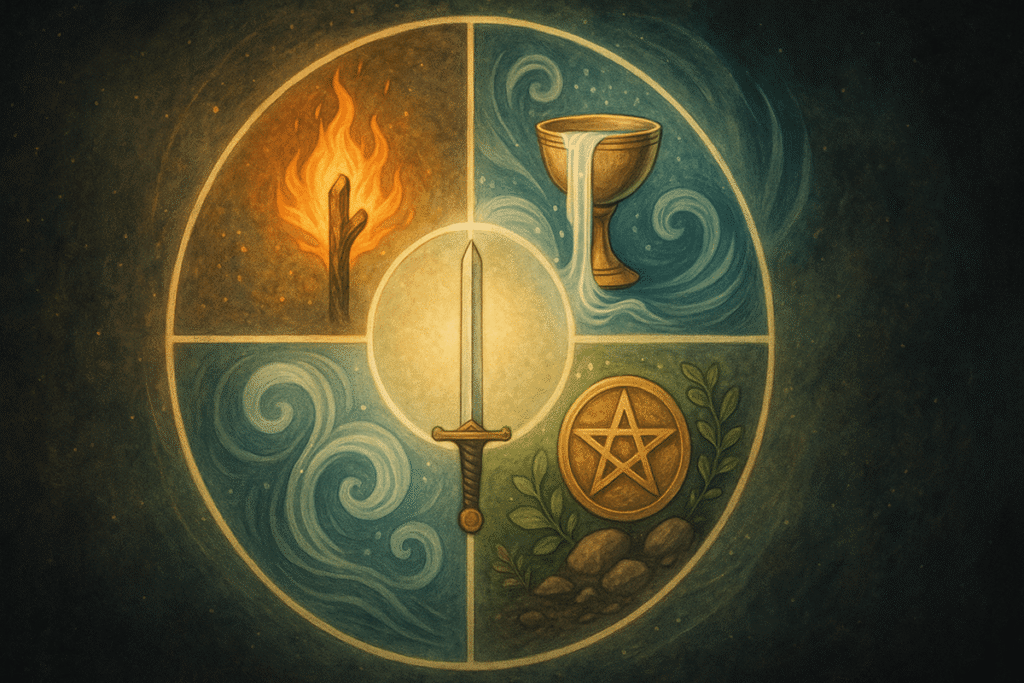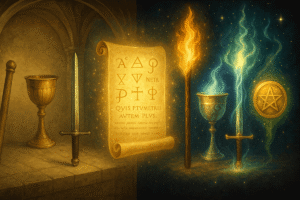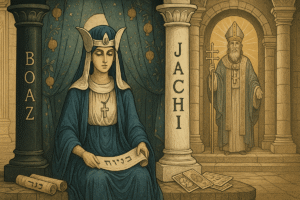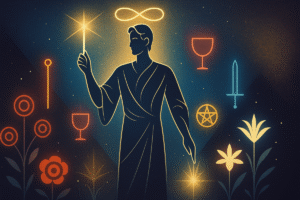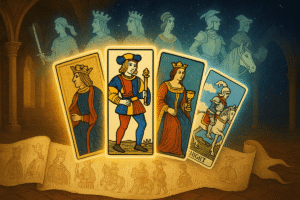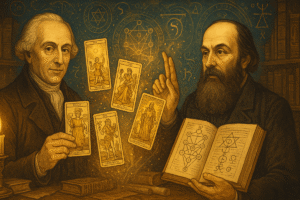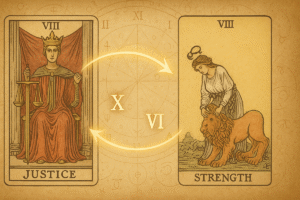Table of Contents
When I first started exploring tarot, I remember being puzzled by why swords represented thoughts while cups dealt with emotions. It wasn’t until I began studying the classical elemental associations that the deeper symbolism clicked into place. The four elements in tarot aren’t just arbitrary categories—they form a philosophical framework that has guided human understanding of the world for thousands of years.
The Minor Arcana’s four suits each align with one of the classical Western elements: Fire corresponds to Wands, Water to Cups, Air to Swords, and Earth to Pentacles. These aren’t random connections but rather a sophisticated symbolic system that invites us to explore different aspects of human experience. Perhaps what makes this framework so enduring is how it mirrors the complexity of our inner lives.
Fire and Wands: The Spark of Inspiration
Fire has always captivated humans. It transforms, creates, and sometimes destroys. In tarot, the suit of Wands carries this elemental energy forward as the realm of passion, creativity, and spiritual drive. When we think about fire’s qualities, what comes to mind? Heat, movement, the need for fuel to survive, and an almost alive quality that makes flames dance and flicker.
The Wands suit embodies these same characteristics in our psychological and spiritual landscape. This is where we encounter questions about our deepest motivations and creative impulses. Fire doesn’t wait—it acts. Similarly, Wands often point us toward examining our relationship with action and initiative.
I find it interesting how fire requires both fuel and oxygen to exist. It makes me wonder about what feeds our own inner fires. What projects or dreams kindle that sense of excitement in your life? When you pull a Wands card, you might reflect on whether you’re feeling energized or perhaps burnt out, whether your creative spark needs tending or redirecting.
The philosophical tradition often associates fire with the realm of spirit and transformation. Ancient alchemists saw fire as the great purifier, burning away what was no longer needed. In this context, Wands cards might invite us to consider what we’re ready to release and what we want to create anew.
There’s something almost restless about fire energy. It’s never quite still, always reaching upward, always consuming. This quality can manifest as the ambitious drive we see in cards like the Two of Wands, or the overwhelming intensity suggested by the Ten of Wands. Fire energy, it seems, is powerful but needs direction.
Water and Cups: The Flow of Emotion
Water moves differently than fire. Where fire leaps and crackles, water flows, pools, and finds its level. The suit of Cups draws from water’s fluid nature to explore the emotional and intuitive aspects of human experience. Water can be gentle rain or a devastating flood, a peaceful lake or turbulent ocean waves.
When I watch water, I’m struck by its persistence. It doesn’t fight obstacles so much as find ways around them, gradually wearing away even the hardest stone. This quality feels deeply connected to how emotions work in our lives. They ebb and flow, sometimes overwhelming us, sometimes barely noticeable, but always present in some form.
The Cups suit invites us to explore our relationship with feelings, intuition, and connection. Water naturally seeks connection, flowing toward other water, finding its way to the sea. Similarly, this suit often deals with themes of love, friendship, and the ways we bond with others.
Perhaps one of water’s most fascinating qualities is its ability to take the shape of whatever contains it. This adaptability appears throughout the Cups cards, suggesting questions about boundaries, empathy, and how we maintain our sense of self while connecting deeply with others.
I think there’s wisdom in water’s teaching about acceptance. It doesn’t resist gravity or fight to flow uphill. Instead, it finds the path that works. When reflecting on Cups cards, we might ask ourselves where we’re fighting the natural flow of our emotions and where we might benefit from greater acceptance or surrender.
Water also holds memory, some say. It carries minerals, nutrients, and information from everywhere it’s been. In the same way, our emotional lives are shaped by every experience we’ve had, every connection we’ve made. The Cups suit seems to honor this depth of feeling and memory.
Air and Swords: The Realm of Thought
Air is perhaps the most subtle of the elements, yet we depend on it completely. We can’t see it, but we feel its movement, notice its absence, and rely on its presence for life itself. The suit of Swords, aligned with the air element, deals with the mental realm—our thoughts, communications, and the invisible but powerful world of ideas.
Like air, thoughts are constantly moving. They can be gentle breezes of inspiration or destructive storms of worry and anxiety. The Swords suit doesn’t shy away from the challenging aspects of mental experience. It acknowledges that our thoughts can both liberate and imprison us.
Air carries sound, enabling communication and connection across distances. This quality appears throughout the Swords suit in themes of conversation, conflict, and the power of words. When we speak, we’re literally using air to carry our thoughts to others. Perhaps this is why the suit often deals with issues of truth, clarity, and miscommunication.
There’s something both liberating and challenging about air’s invisibility. We can’t grab hold of it or pin it down, much like trying to control our thoughts. The more we struggle to force our minds into rigid patterns, the more elusive peace becomes. I wonder if this is why meditation traditions often use breath as a focus—air connects us to the present moment while remaining fundamentally free.
The philosophical tradition associates air with the realm of intellect and higher consciousness. It’s the element that rises above earthly concerns, seeking perspective and understanding. Yet Swords cards remind us that this mental realm can become a prison of overthinking or a battlefield of conflicting ideas.
Weather patterns show us air’s power to create both calm and chaos. Similarly, our mental landscapes can shift dramatically, from clear thinking to emotional storms. The Swords suit invites us to observe these patterns without being overwhelmed by them.
Earth and Pentacles: The Foundation of Manifestation
Earth grounds us. While the other elements move and change, earth provides stability, substance, and the foundation for growth. The suit of Pentacles, connected to the earth element, explores themes of material security, practical concerns, and the physical world we inhabit.
I’m always amazed by earth’s patience. Seeds can wait in soil for exactly the right conditions before sprouting. This quality of timing and natural cycles runs throughout the Pentacles suit. Unlike fire’s urgency or air’s quick movement, earth energy teaches us about steady progress and the value of sustainable growth.
Earth supports life by providing nutrients, structure, and a place for roots to take hold. In our lives, this might translate to questions about what provides us with stability and nourishment. What are your roots? What gives you a sense of security and belonging?
The suit of Pentacles often deals with work, money, and resources, but I think it’s really about something deeper—our relationship with the physical world and our ability to manifest our ideas into tangible reality. Earth takes the formless and gives it structure, just as we take our dreams and aspirations and work to make them real.
There’s a cyclical quality to earth that fascinates me. Seasons change, things grow and decay, returning to soil that nourishes new life. This suggests that the Pentacles suit isn’t just about accumulation but about understanding the natural cycles of abundance and scarcity, growth and rest.
Earth also teaches us about limits and boundaries. Unlike water, which flows freely, or air, which expands to fill space, earth has definite form and substance. This quality appears in Pentacles cards that deal with practical constraints, resource management, and the need to work within reality’s parameters.
Integrating Elemental Wisdom
The beauty of the elemental system lies not in seeing these forces as separate but in recognizing how they interact within us. We all contain fire’s passion, water’s intuition, air’s curiosity, and earth’s practical wisdom. The tarot simply gives us a framework for exploring how these energies manifest in different areas of our lives.
Sometimes I wonder which element feels most natural to you right now. Are you drawn to fire’s creative energy, water’s emotional depth, air’s mental clarity, or earth’s grounding presence? These preferences might shift based on what you’re experiencing or what you need most.
The Minor Arcana, through its elemental structure, offers us a mirror for examining the full spectrum of human experience. It suggests that wholeness comes not from choosing one element over others but from understanding how they all contribute to our growth and understanding.
Perhaps the most profound insight from studying the four elements in tarot is recognizing that we’re not meant to live in just one elemental realm. The richest life includes fire’s inspiration, water’s compassion, air’s wisdom, and earth’s practical engagement with the world. Each element has gifts to offer and lessons to teach.
Frequently Asked Questions
Do all tarot decks show the elemental symbols clearly?
Not every deck makes the elemental connections visually obvious. The Rider Waite Smith deck and similar traditional decks are rich with elemental imagery, while more minimalist decks like the Wild Unknown might require you to rely more on understanding the suit associations. If you’re just starting to work with the elements, choosing a deck with clear visual symbolism can make your exploration easier and more intuitive.
How do the elements interact with each other in a reading?
When multiple cards appear together in a spread, their elements create a dynamic relationship. This concept is sometimes called elemental dignities. For example, Fire and Air work well together because air feeds fire, just as mental clarity can fuel passionate action. Fire and Water, however, oppose each other since water can extinguish flames, suggesting that emotions might be dampening your drive. These interactions aren’t about good or bad but rather about understanding the energetic dynamics at play in your situation.
Which element is most important?
I’ve heard people debate this, with some seeing fire as the highest element while others view it as the most fundamental. The truth is that no single element holds more importance than the others. Each represents a vital aspect of human experience, and we need all four to function fully. You might naturally resonate more with one element based on your personality or current life circumstances, but wholeness comes from honoring and developing your relationship with all four elemental energies.

